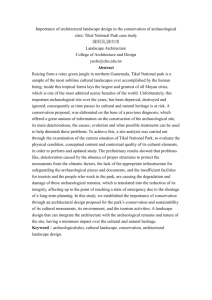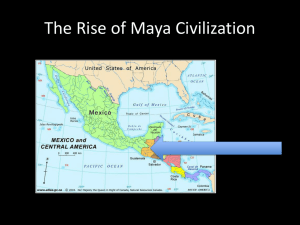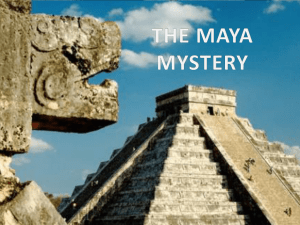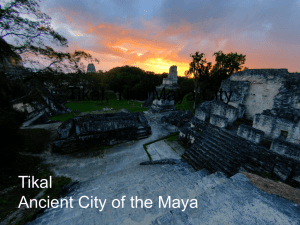Fall 2009
advertisement
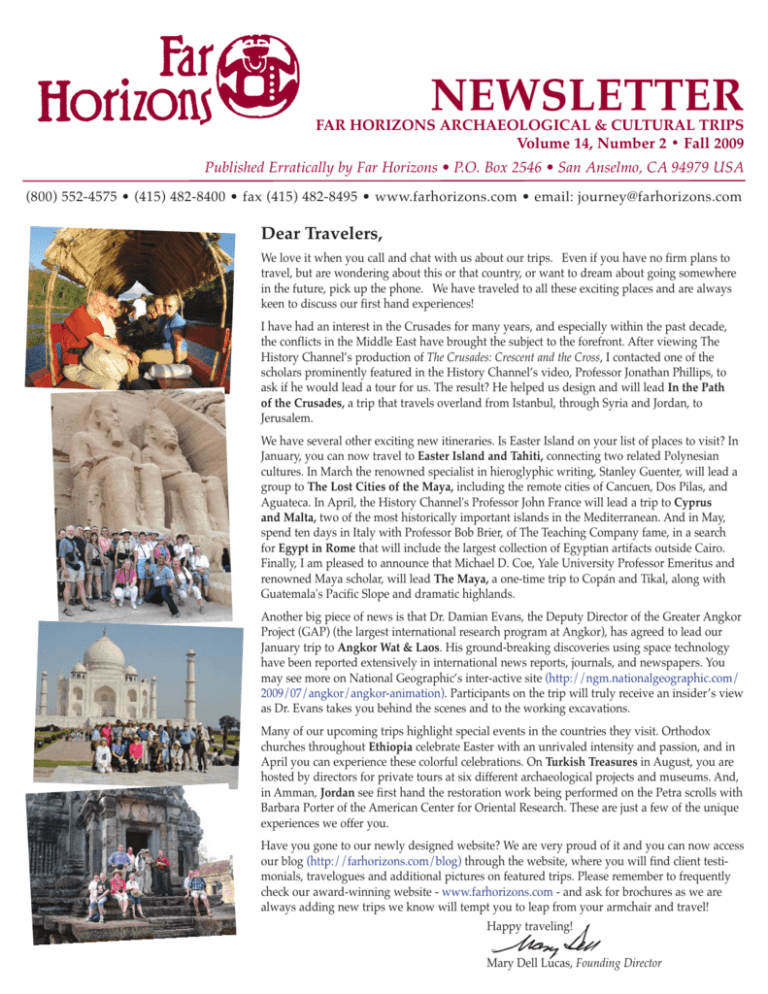
NEWSLETTER FAR HORIZONS ARCHAEOLOGICAL & CULTURAL TRIPS Volume 14, Number 2 • Fall 2009 Published Erratically by Far Horizons • P.O. Box 2546 • San Anselmo, CA 94979 USA (800) 552-4575 • (415) 482-8400 • fax (415) 482-8495 • www.farhorizons.com • email: journey@farhorizons.com Dear Travelers, We love it when you call and chat with us about our trips. Even if you have no firm plans to travel, but are wondering about this or that country, or want to dream about going somewhere in the future, pick up the phone. We have traveled to all these exciting places and are always keen to discuss our first hand experiences! I have had an interest in the Crusades for many years, and especially within the past decade, the conflicts in the Middle East have brought the subject to the forefront. After viewing The History Channel’s production of The Crusades: Crescent and the Cross, I contacted one of the scholars prominently featured in the History Channel’s video, Professor Jonathan Phillips, to ask if he would lead a tour for us. The result? He helped us design and will lead In the Path of the Crusades, a trip that travels overland from Istanbul, through Syria and Jordan, to Jerusalem. We have several other exciting new itineraries. Is Easter Island on your list of places to visit? In January, you can now travel to Easter Island and Tahiti, connecting two related Polynesian cultures. In March the renowned specialist in hieroglyphic writing, Stanley Guenter, will lead a group to The Lost Cities of the Maya, including the remote cities of Cancuen, Dos Pilas, and Aguateca. In April, the History Channel's Professor John France will lead a trip to Cyprus and Malta, two of the most historically important islands in the Mediterranean. And in May, spend ten days in Italy with Professor Bob Brier, of The Teaching Company fame, in a search for Egypt in Rome that will include the largest collection of Egyptian artifacts outside Cairo. Finally, I am pleased to announce that Michael D. Coe, Yale University Professor Emeritus and renowned Maya scholar, will lead The Maya, a one-time trip to Copán and Tikal, along with Guatemala's Pacific Slope and dramatic highlands. Another big piece of news is that Dr. Damian Evans, the Deputy Director of the Greater Angkor Project (GAP) (the largest international research program at Angkor), has agreed to lead our January trip to Angkor Wat & Laos. His ground-breaking discoveries using space technology have been reported extensively in international news reports, journals, and newspapers. You may see more on National Geographic’s inter-active site (http://ngm.nationalgeographic.com/ 2009/07/angkor/angkor-animation). Participants on the trip will truly receive an insider’s view as Dr. Evans takes you behind the scenes and to the working excavations. Many of our upcoming trips highlight special events in the countries they visit. Orthodox churches throughout Ethiopia celebrate Easter with an unrivaled intensity and passion, and in April you can experience these colorful celebrations. On Turkish Treasures in August, you are hosted by directors for private tours at six different archaeological projects and museums. And, in Amman, Jordan see first hand the restoration work being performed on the Petra scrolls with Barbara Porter of the American Center for Oriental Research. These are just a few of the unique experiences we offer you. Have you gone to our newly designed website? We are very proud of it and you can now access our blog (http://farhorizons.com/blog) through the website, where you will find client testimonials, travelogues and additional pictures on featured trips. Please remember to frequently check our award-winning website - www.farhorizons.com - and ask for brochures as we are always adding new trips we know will tempt you to leap from your armchair and travel! Happy traveling! Mary Dell Lucas, Founding Director An Easter Anniversary of “Surging” Pride By Dr. Steven Fischer May 22, 2010, will mark the fiftieth anniversary of a cataclysmic event in Easter Island’s history. It all began just off Chile’s shore on May 21, 1960. This was the day the Chilean metropolis of Concepción crumbled under an unprecedented earthquake —at 9.5 on the Moment-Magnitude Scale the most powerful that humankind has experienced. Follow-on tsunamis hit Alaska, New Zealand and even far-away Japan where some 200 died Tongariki statues and 50,000 lost their homes. Tiny, isolated Easter Island, too, was not spared. On May 22, 1960, a tsunami struck the island’s uninhabited south-eastern coast and swept the holy site of Tongariki’s giant “moai” statues, among the largest on Easter Island, as far as 100 metres inland. Whereupon the backwash then obliterated the holy precinct. No Easter Islander was killed. No mortal eye witnessed the cataclysm. But the next day most of the island’s small population rushed to view the damage. Many gasped. Some cried. Glorious Tongariki had been washed away. Our Far Horizons’ Tahiti-Easter Island group will soon stand above this very site, nearly fifty years to the day after that unforgettable event. Our panoramic view will have us gasping, too … but now with amazement. For Tongariki is admittedly one of the Pacific’s premier archaeological monuments. In 1992 Japan’s Tadano Crane Company funded restoration work and donated a gigantic crane to see that it was completed properly. Under the leadership of Chilean archaeologist Claudio Cristino, Tongariki and its towering moai rose again. By 2002 both of Tongariki’s wings had been fully restored and all fifteen moai stood majestically upon their high, fitted-stone platform, eyes lifted once more toward the heavens. Indeed, the holy site looked very much as it would have done back in the brilliant fifteenth century. Today, fifty years after that devastating tsunami that visited Easter Island so terribly, Tongariki comprises one of the most splendid archaeological centers—a museum of monolithic magnificence— anywhere in the Pacific Islands. It is the pride of Rapa Nui. Tongariki alone would justify a visit to Easter Island. Travel with Dr. Fischer to Tahiti and Easter Island on February 2-14, 2009. Angkor By Damian Evans, PhD Some of you may have seen the recent coverage of our ongoing research at Angkor, in Cambodia, as part of a National Geographic special which included a cover story in the July edition of the magazine and the airing of a one hour feature documentary. The multimedia special, which is still live on the National Geographic website - http://ngm.nationalgeographic.com/2009/07/angkor/ angkor-animation and http://ngm.nationalgeographic.com/2009/07/angkor/ stone-text, shows for the first time some faithful reconstructions of daily life during the classical Angkorian period which are based on more than a decade of archaeological research by members of our team. Recently, a number of new discoveries have come to light: studies of tree rings in ancient trees in the Beng Mealea temple region, for example, have provided evidence that Angkor suffered from a series of ‘mega-droughts’ during the period of its decline, which offers additional insight into the role that Angkor’s vast water management system played in the collapse of the civilisation. With the recent introduction of modern archaeological research to Cambodia, the history of the Khmer Empire is being rapidly rewritten — for example, most scholars no longer believe the traditional explanation that the collapse of Angkor was caused by a Thai invasion in 1431 AD, but it will take a couple of years at least before these findings will filter through to guide books and histories. The fifty or so researchers on our Australian archaeological project continue to be at the forefront of developments in the field, and the upcoming tour will engage closely with the latest research to ensure that participants get more than the ‘standard line’ on the cultural history of Cambodia and Laos. The global economic situation has hurt tourism in Cambodia quite badly, and there has been a sharp downturn in the number of tourists coming to Angkor this year. However, several additional sites in Cambodia are due for World Heritage listing and visitor numbers are expected to rebound sharply in 2010-2011. In the meantime, the good news for us is that we have the opportunity to experience Angkor much the same as it was some years ago, before the massive influx of tourists pushed visitor numbers over one million annually. Although Angkor has been under increasing pressure from tourism, we now have a very rare window to appreciate the majesty of the temples and their forest setting in relative serenity, not to mention picking up some terrific bargains in rare silks, artworks, and stone carvings (reproductions, of course!) in both Cambodia and Laos. Travel to Cambodia and Laos with Dr. Damian Evans January 3 - 20, 2010. 2 • www.farhorizons.com Egypt Discovery! By Professor Bob Brier During our March 2008 Oases trip, we made an important discovery while 4-wheeling through the North Kharga Oasis with Salima Ikram, Director of the North Kharga Oasis Survey (NKOS). NKOS is an archaeological project of the American University in Cairo and co-directed by Salima Ikram and Corinna Rossi. NKOS’s goal is to investigate and map all archaeological remains found in the northeastern part of Kharga Oasis—the largest of several oasis in Egypt. Many of our group members were returning for their second or third tours with us, and had met Salima at our dinner lectures. Over the years she has talked about the progress the Survey has made and about the sad destruction of several sites by looters looking for treasure. Her site is huge, remote, and nearly impossible to guard. Salima, with the help of her GPS, guided us to several remote desert sites that she and her team are mapping. It was a day filled with adventure. Our goal was to explore three ancient Roman fortresses: Qasr el-Labeka, a large site with two temples, a cemetery and an aqueduct, Ain Umm Dabidib another site with an amazing collection of buildings, tombs and aqueducts, and the most impressive site, El-Deir, a majestic mudbrick Roman fortress situated to protect the caravans traveling Far Horizons group at “Far Horizons” between the oasis and the Nile. As our Land Rovers crisscrossed the desert terrain, we stopped to marvel at the rock art and the natural formations, and to confirm our location on the GPS. At one stop we all piled out of the 4x4s to stretch our legs and quickly noticed what seemed to be the remains of an archaeological site. We asked Salima to check it, and she determined that we had come upon a very ruined site that had never been identified or mapped. It remains to be discovered what the site was, but we named it ‘Far Horizons’. Travel with Bob Brier on several trips in 2010 – Majesty of Egypt, Egypt in Rome, Oases of Egypt Philippe de Mézières, Chancellor of Cyprus, and the Military History of the Fourteenth Century By Professor John France attacked and captured Alexandria in 1365. Cyprus in the mid-14th century was the last But Cyprus lacked the military strength to crusading state in the Middle East. Its largeoccupy the city which was plundered, and ly Greek population was dominated by almost immediately surrendered back to the French nobles led by kings from the house Mamluk Sultan. Nevertheless, this was a of Lusignan whose great castles are now great coup, and because of it Cyprus picturesque ruins. The very purpose of a became the very symbol of the struggle crusading kingdom was to wage war for the against Islam in the Mediterranean. But the liberation of Jerusalem, yet Cyprus was French nobles of Cyprus were uneasy as overshadowed by the Turks of Asia Minor these nobles increasingly believed they had to the north and the enormous power of the been committed to a war which they could Mamluks of Egypt to the south. But King Paphos Castle not win. In 1369 intrigue exploded with the Peter I of Cyprus was convinced that he assassination of King Peter, and Philippe de Mézières fled to must challenge these enemies or be destroyed by them. In France where he became an adviser to the French king and a this he was aided by a passionate young Frenchman, Philippe great advocate of the crusade. de Mézières who, having fought the Turks victoriously at Smyrna (in present day Turkey), visited Jerusalem in 1346/7 Cyprus during the period of the Crusades was even then an where he underwent a deep spiritual experience which ancient land with a vital strategic position in the eastern prompted him to found a new religious order, the ‘Order of Mediterranean, but beneath its beauties lay a world of the Passion’ whose great objective was to liberate Jerusalem intrigue and hatred. from Muslim control. He became Peter I’s Chancellor of Cyprus, and together they planned a series of attacks on the Turks of Anatolia and the Mamluks of Egypt. In 1364 the young king of Cyprus toured Europe and raised a fleet and a great army with which he Don’t miss an exceptional opportunity to travel with the History Channel’s Professor John France on Far Horizons new tour April 10 – 23, 2010 to Cyprus & Malta: Historic Isles of the Mediterranean. www.farhorizons.com • 3 A Marquesan Adventure By Sidsel Millerström, PhD It is a monumental challenge to get around in the Marquesas. No regular transportation exists between all the villages and islands. While there are regular flights to some of the big islands in the Marquesas, my favorite mode of transportation is the working freighter-passenger ship Aranui that voyages between Tahiti, through the Tuamotus and then visit several of the villages in the six presently inhabited islands. After stopping a day in one of the Tuamotu islands, usually Takapoto or Fakarava, we spend a day at sea. Because of the clean air I can smell the wild oregano in the Marquesas before we catch sight of the dramatic peaks of Ua Pou, the first entry to the archipelago. The view continues to charm and it is always a dramatic entrance. I am in good company. In 1907, on December 6th at around 5 o’clock in the morning, Jack London and his wife Charmian sailed the Snark into Taohaie Bay in the midst of a squall. The “fairyland” atmosphere in the amphitheatre valley with the looming cliffs and wild goats spellbound them. Other well-known visitors such as Robert Louis Stevenson, Paul Gauguin, and Thor Heyerdahl also made the Marquesas their home for a period of time. One of the impressive bays is Puamau, located on the north east coast of Hiva Oa. Me’ae Iiopona, a large and complex prehistoric ritual site, recently restored, displays nine anthropomorphic stone sculptures, called tiki in Polynesia. Many are still standing in their original spots among architectural stone remains. My favorite valley is Hatiheu located on the north coast of Nuku Hiva. Its dramatic landscape and friendly people makes one want to settle into the tranquil atmosphere. Over the Aranui years I have spent numerous archaeological field seasons surveying the entire region mapping and describing prehistoric architecture and rock art. Over 3,000 individual pecked figures were documented in Hatiheu Valley alone, along with many temples, tribal ceremonial plazas, and domestic households. Everything were mapped, described, and analyzed. The research resulted in a dissertation earned at the Department of Anthropology, University of California at Berkeley. Yvonne Katupa, the energetic mayor, greatly facilitated my project. For years she has welcomed hungry and sometimes lonely archaeologists, enhanced her valley with plants and flowers, painted local history and archaeological images on school walls and has impressed such images into a village bridge. Accessible archaeological sites, welcoming people, good food, and dramatic landscape make the Marquesas Island trip a unique adventure not to be missed, never to be forgotten. Travel with Dr. Millerström aboard the Aranui III on Voyage through the Marquesas Islands, May 12-29, 2010. Why Syria? By Professor Amr Al-Azm Syria is a repository for a phenomenal catalogue of cultural and material heritage amassed over thousands of years. This wealth of heritage is primarily a result of the role played by Syria as a crucible in the development of numerous civilizations in the Near East. Interactions between these civilizations and other neighboring cultures, which were often as part of trade relations, conquest and integration or assimilation into other cultures further enriched this immense legacy. By joining us on our trip across Syria you will be able to experience this rich corpus of great cultural and material history by literally walking through a living museum and witnessing the deeds of such men and women as Alexander the Great, Queen Zenobia and Saladin. See for yourself wonderful artifacts from the world’s first alphabet to the treasures of great city-states such as Ugarit, Mari and Ebla. Wander the longest colonnaded Cardo Maximus in the world at Apamea, seat your self in the exceptionally intact Roman amphitheatre at Bosra and 4 • www.farhorizons.com imagine the loud cheers for the gladiatorial contests which took place here, and feel the first warming rays of the desert sun as Krak de Chevalier you greet the dawn at the temple of Bel in Palmyra following a tradition practiced by worshipers nearly two thousand years ago. I hope that you will join me on this wondrous journey of cultural discovery and enjoy the mystique of the Orient that has been so attractive to travelers and scholars since the 18th century. Travel with Dr. Al-Azm to Syria May 22-June 6, 2010. A Tale of War and Revenge from an Ancient Maya Vase By Stanley Paul Guenter (636-686) he dominated the Maya A beautiful polychrome Maya vase world. In 648 a civil war broke out in preserves a bit of a mystery. This vase the kingdom of Tikal that pitted Tikal’s depicts the king of Tikal, Jasaw Chan king, Nuun Ujol Chaak, against his K’awiil, seated upon a throne and brother, Bajlaj Chan K’awiil, who had receiving tribute brought in by a established his rebel base at the small kneeling individual wearing a peccary site of Dos Pilas. Yuhknoom Ch’een headdress in the center of the scene. took advantage of this situation and This individual, named K’ahk’ Hix following a strategy of “divide and Muut in an accompanying hieroglyphic conquer” he conquered first Dos Pilas caption (his name means “Fire Jaguar Photograph © Justin Kerr. in 650, and Tikal itself in 657. An eroded Bird”), carries his tribute in a bundle (http://www.famsi.org/research/kerr/index.htm) hieroglyphic stairway at Dos Pilas strapped to his back and delicately records the final act in this war, in places a hand on the arm of the king. which both Bajlaj Chan K’awiil and Nuun Ujol Chaak had to Some of his tribute has already been delivered, and sits on the recognize the young heir to the throne of Calakmul, none throne behind the king. This consists of a bundle of white other than Jaguar Paw himself, as their future overlord. The cloth, with a spray of feathers on top. Cloth and quetzal feathevent is said on this stairway to have been staged not in ers were standard objects of tribute throughout Mesoamerica. Calakmul, nor in Tikal or even in Dos Pilas. Rather, it took Three lords of the Tikal royal court frame this scene. The place at Yaxha, a great city to the southeast of Tikal that was unnamed figure to the right bears a torch to light the area, one of Tikal’s major allies. This must have been a humiliating which is shown taking place within a building by the curtains event for these Tikal princes and it was a situation that could drawn up at the top of the scene. The kneeling figure behind not last in the volatile world of ancient Maya politics. In 672 K’ahk’ Hix Muut is named Chak Tahn Moow and bears the the civil war within the Tikal kingdom broke out again, with Emblem Glyph of Tikal, identifying him as a member of the Nuun Ujol Chaak attacking Dos Pilas and driving Bajlaj Chan royal family and probably a relative of the king. The figure to K’awiil into exile in Calakmul. With Calakmul’s help, Bajlaj the far left is the most remarkable as he is portrayed facing Chan K’awiil ultimately defeated his brother and re-estabthe viewer, one of the few frontal images ever painted by the lished himself as king of Dos Pilas. ancient Maya. This person is named Tetchin and is titled Baah Jasaw Chan K’awiil, son of Nuun Ujol Chaak, came to the Ajaw, or “First Lord”, an indication that he was the head of throne of Tikal in 686 and it seems to have been his goal to the local non-royal nobility. A closer observation of his face gain revenge for his father. Rather than restart the civil war shows that he is smoking a thin cigar. with Dos Pilas, Jasaw Chan K’awiil seems to have gone for What makes this scene remarkable is the fact that K’ahk’ Hix the jugular and the evidence suggests he focused his attack on Muut is said in his hieroglyphic caption to have been an emisCalakmul itself. While he gained his ultimate revenge in 695, sary of the Calakmul king, Yuhknoom Yich’aak K’ahk’, better with the defeat of the Calakmul ruler to whom his father had known to Mayanists as “Jaguar Paw”. Calakmul was ancientbeen forced to pledge his fealty, he apparently scored earlier ly known as the “Snake Kingdom” and its ruler Jaguar Paw successes that forced this Calakmul king to sue for peace a came to the throne in 686 and was defeated by Tikal’s king number of years earlier. Knowing what we now know about Jasaw Chan K’awiil in 695. One would expect this scene of Nuun Ujol Chaak’s difficult past, we can understand why tribute from Calakmul’s king to the throne of Tikal to be postJasaw Chan K’awiil received tribute from Jaguar Paw at 695 but in fact the vertical text to the far right of the scene Topoxte. Topoxte was an island within sight of the city of (painted as if upon a wall of the structure in which the scene Yaxha and by staging this reception of tribute here Jasaw takes place) dates the event to 691 and records that it took Chan K’awiil managed to wipe away the stain of humiliation place not at Tikal but at Topoxte, a small island in Lake Yaxha, on his family and his kingdom and gain revenge for his to the southeast of Tikal. Why was Calakmul’s king sending father. While we do not know all of the intricacies of the an emissary to deliver tribute to Tikal four years before the dramatic events of ancient Maya history, we can occasionally climactic final battle? And why did this event take place uncover tales such as this from the monuments and outside of Tikal on a small island in the neighboring kingdom inscriptions that have survived the centuries in the jungles of Yaxha? of the land of the Maya. Unfortunately, the fragmentary state of the corpus of Maya inscriptions means that we do not understand what events transpired to bring about such a situation but it is noteworthy that only a dozen years earlier the roles had been reversed. In 679 Jasaw Chan K’awiil’s father was defeated by his brother, Bajlaj Chan K’awiil, a vassal of Jaguar Paw’s father, Yuhknoom Ch’een the Great of Calakmul. Yuhknoom Ch’een deserved his epithet of “the Great” as during his 50 year reign Visit the places where these dramatic events took place: • Calakmul on our Hidden Cities of the Yucatan tour, February 6-21, 2010 • Tikal on our Capital Cities of the Ancient Maya tour, March 3-13, 2010 • Dos Pilas, Tikal and Yaxha on our Lost Cities of the Maya tour, March 18-28, 2010 www.farhorizons.com • 7 PRESORTED FIRST CLASS MAIL U.S. POSTAGE PAID ALBUQUERQUE, NM PERMIT NO. 1888 P.O. Box 2546 San Anselmo, CA 94979 USA RETURN SERVICE REQUESTED Call or Email Today for Trip Brochures! w w w . f a r h o r i z o n s . c o m Zoroastrians in Iran Zoroastrians in Iran By Dr. Jennifer Rose By Dr. Jennifer Rose Fire-holder Most Americans do not realize that there are many different religious traditions in Iran, several of which have existed there for centuries, including Zoroastrianism, Judaism and Christianity. The Zoroastrian – or “Mazda worshipping” – religion is one of the oldest in the world, dating back over three thousand years. It arose amongst Iranians before they had settled in the land we now know as Iran, and endured as the main religion of the country for over a millennium, until the arrival of Islam. Evidence of worship of Ahura Mazda, the supreme divinity, is found on the inscriptions of the Ancient Persian kings Darius I, Xerxes and Artaxerxes, and was known as a key element of “Persian” religion to classical Greek writers, including Aristotle. Zoroastrianism continued to develop from the time of the Ancient Persians, through the rule of the Seleucid Greeks, then the Iranian Parthians. Under the Sasanians, the religion was closely linked with the state, and became more institutionalized, with a hierarchical priesthood and endowed fire temples. Fire remains a key emblem of the religion, functioning as a visual index of the order and “rightness” which Ahura Mazda, as creator, brings to the world. Mazda worshippers choose to promote that rightness and justice in their own lives, and to combat all that is destructive or deceptive. This approach to life is expressed in the Zoroastrian trifold ethic of “Good Thoughts, Good Words, Good Deeds.” Each Zoroastrian community in Iran has a fire temple, known as an atashkadeh or dar-e mihr, which is open to visitors. Zoroastrian belief and practice recognizes the importance of all the elements of creation, so there is usually a source of flowing water nearby, and a garden with flowers and trees. According to recent statistics, there are probably somewhere between 25-40,000 Zoroastrians in Iran. Most now live in Tehran, although there are substantial communities in and around the desert cities of Yazd and Kerman, as well as Shiraz and Isfahan. Despite dwindling numbers, these communities continue to celebrate many of the ancient festivals, such as Nav Ruz (New Year), and to maintain traditional practices. Each community has its own anjuman (association), and the Zoroastrians as well as the Christians and Jews must by law have one representative in the National Islamic Parliament (majles). Travel with Dr. Rose to Iran April 25-May 11, 2010, a remarkable trip to a unique and rewarding destination. (800) 552-4575 • (415) 482-8400 • fax (415) 482-8495 • www.farhorizons.com • email: journey@farhorizons.com
